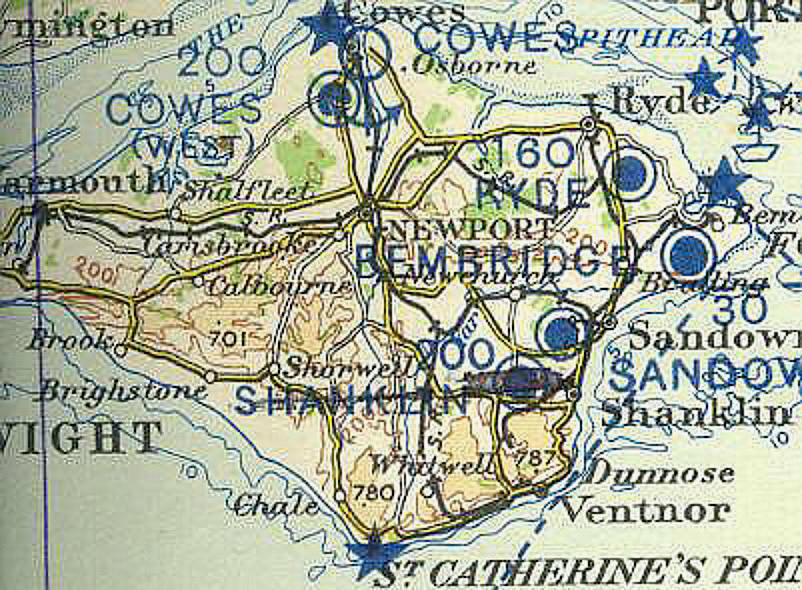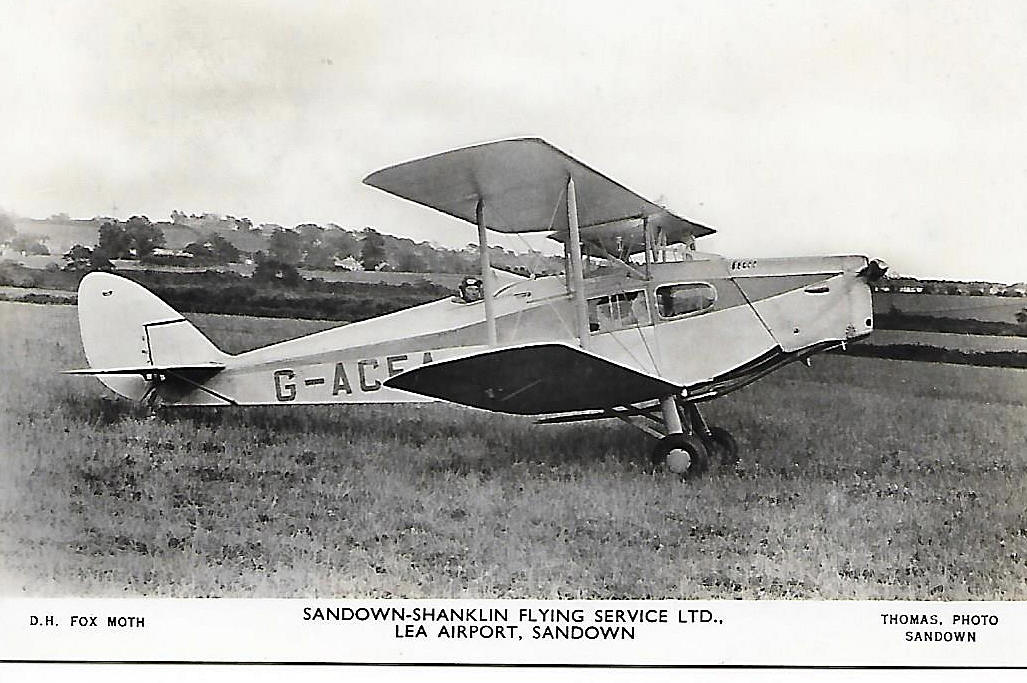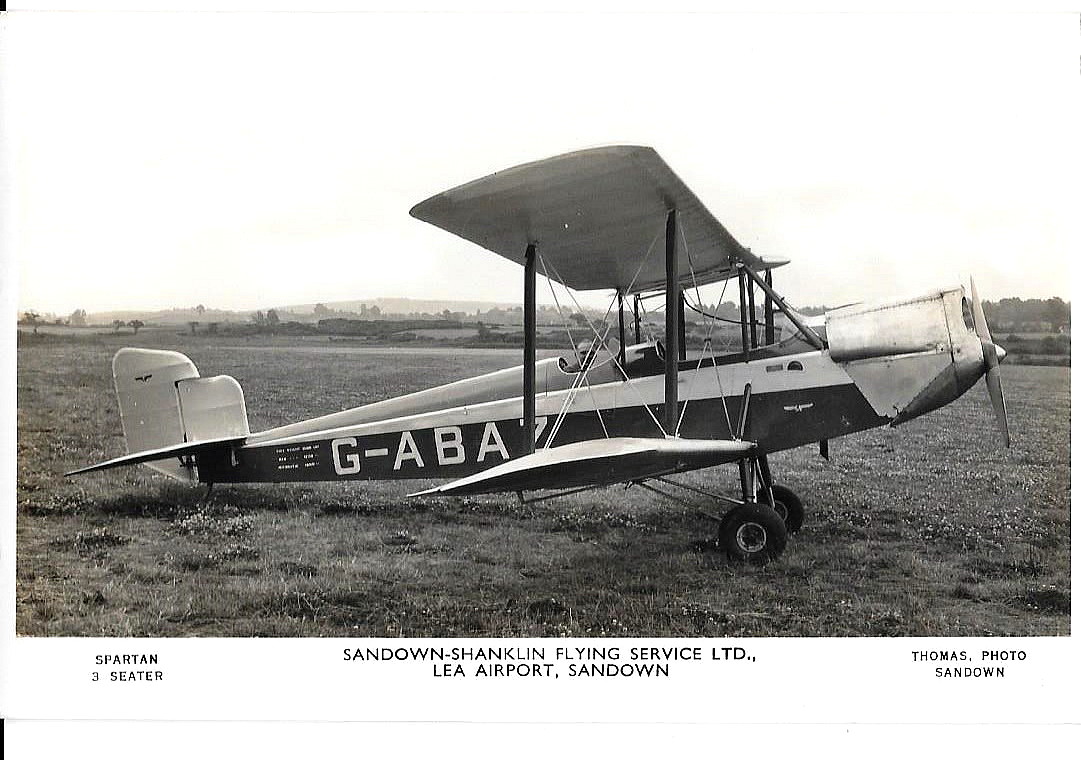Lea
LEA: Civil aerodrome (Also referred to as LEA AIRPORT)
Now mostly incorporated into the site of SANDOWN aerodrome it seems. So, not exactly the same site in area, but in most aspects identically similar.
Note: The second and third pictures from postcards of the Fox Moth G-ACEA and Spartan Three Seater 1 G-ABAZ were kindly sent by Mike Charlton who has an amazing collection. See: www.aviationpostcard.co.uk
The DH83 Fox Moth G-ACEA was first registered on the 30th March 1933. It became registered to Sandown-Shanklin Flying Service on the 17th July 1936 and served with them until the 26th August 1939. I suspect it was mostly used for 'pleasure flights' but quite likely used for anything else on offer, such as air-taxi and charter perhaps? On the 20th of September 1939 it was registered to the Isle of Wight Flying Club, and I suspect, with WW2 imminent, the Sandown-Shanklin Flying Service were keen to get rid of it at a decent price? It was impressed into RAF service as AW124 on the 23rd of June 1940.
The Spartan Three Seater 1, G-ABAZ, was first registered on the 26th June 1930, and classified as an aerobatic type. It appears that it served the Sandown-Shanklin Flying Service until the 11th December 1935 when it became registered to the Isle of Wight Flying Club. What seems of interest is that the registration wasn't cancelled until December 1946.
Did it somehow escape being impressed for military service during WW2? Any advice will be most welcome.
Airline user: Spartan Air Lines
Flying club: Isle of Wight Flying Club
Pleasure flights: Sandown-Shanklin Flying Service
Location: Off Landguard Manor Road, near Sandown, very near to Sandown golf course
Period of operation: 1935 to 1939 only?
Runways: Landing area: Initially roughly 457 with a minimum of 189 metres. Increased to 594 and 338 in 1937. All grass of course
NOTES: The DH.60 Moth G-EBRY, owned by the Isle of Wight Flying Club is reported to have been operating this aircraft from Lea Airport in 1939. Soon after was impressed into miltary service as AW147.
Venue (13th August) for Alan Cobham’s 1935 No.1 Tour.
Base for Sandown & Shanklin Flying Services (?), who, in the 1930s operated a Spartan Arrow and a Spartan ‘Three-seater’ on the island for joy-riding flights.
A NEW SERVICE
I think this is well worth quoting from Neville Doyle in his excellent book The Triple Alliance: “On June 1st 1935, a completely new service began between Heston and Sandown which was nominally quite separate from the Bembridge – Cowes service”.
“PSIOWA, meanwhile, continued flying from Heston to Shanklin, just down the road.” And here comes the astonishing news: “The airfield used by Spartan was at Sandown (Lea) whilst that used by PSIOWA was at Shanklin (Apse). At this time, there were no less than three aerodromes within a two-mile radius of Shanklin Pier.” It seems that all the airlines serving the Isle of Wight were determined to remain completely independent, regardless of the extra expense involved in not sharing facilities.
A FLYING CIRCUS ARRIVES
Venue (13th August) for Alan Cobham’s 1935 No.1 Tour.
A NEW SITUATION
The entire situation was soon to change when, on the 30th September 1935 Allied British Airways Ltd had been formed to take over Spartan Air Lines, United and Hillmans’ Airways.
All achieved by October and the merger went ahead. The name was changed to British Airways on the 29th October 1935.
THE SPARTAN FLEET
The Spartan fleet on the 30th September 1935 consisted of five Spartan Cruisers; G-ACBM, G-ACVT, G-ACYK, G-ADEL and G-ADEM plus a DH.84 Dragon G-ACNG. The existence of the DH84 Dragon in the Spartan fleet strikes me as being very significant – surely it must have been viewed as superior for certain duties – but what were these?
Neville Doyle describes the fleet in June 1935 as being one Saro Cloud G-ABXW, one DH.84 Dragon G-ACNI, five Spartan Cruisers as above and a Spartan Three-seater G-ABTR. So, why was the DH Dragon G-ACNI replaced so soon afterwards by G-ACNG?
We'd love to hear from you, so please scroll down to leave a comment!
Leave a comment ...
Copyright (c) UK Airfield Guide


















